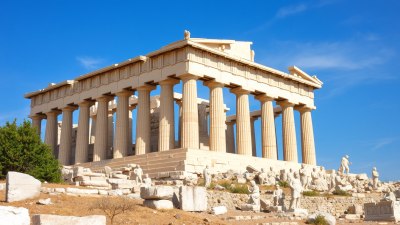Athens' Ancient Ruins: Walking in the Footsteps of Gods and Philosophers
Explore the rich history of Athens' ancient ruins, where gods and philosophers once walked. Discover their stories in this comprehensive guide.

Image created with Flux Schnell
The city of Athens, known as the cradle of democracy and philosophy, boasts a remarkable tapestry of ancient ruins that whisper tales of gods, heroes, and great thinkers. Walking through these storied sites is like stepping back in time, allowing you to experience the grandeur of a civilization that has significantly shaped human history. This article serves as a detailed guide to some of the most notable ancient ruins in Athens, providing insights into their historical significance, architectural marvels, and the legends that surround them.
The Acropolis: A Symbol of Ancient Greece
Dominating the Athenian skyline, the Acropolis is perhaps the most iconic of all ancient ruins. This ancient citadel, perched atop a rocky outcrop, is home to several significant structures, the most famous being the Parthenon. Built in the 5th century BC, the Parthenon was dedicated to the goddess Athena, the protector of the city. Its stunning Doric columns and intricate sculptures exemplify the pinnacle of ancient Greek architecture.
As you wander around the Acropolis, take time to explore the Erechtheion, known for its Caryatids—six elegant female figures that replace traditional columns. The Erechtheion is significant because it housed the sacred olive tree, which, according to myth, Athena offered to the city in a contest against Poseidon.
The Agora: Heart of Ancient Athens
Once the bustling center of Athenian life, the Agora was the beating heart of public life and commerce. Here, citizens gathered for political discussions, philosophical debates, and marketplace activities. The ruins of the Agora are extensive, with notable structures such as the Stoa of Attalos, which has been reconstructed to house the Agora Museum. This museum offers artifacts that provide insight into the daily lives of Athenians.
One of the most important sites within the Agora is the Temple of Hephaestus, often referred to as the best-preserved ancient temple in Greece. Built in the 5th century BC, it was dedicated to Hephaestus, the god of craftsmanship and fire. The temple's imposing structure and beautiful friezes showcase the artistic achievements of the period.
Plaka: The Old Neighborhood
While not an ancient ruin per se, the Plaka neighborhood offers a charming glimpse into the past with its narrow streets and neoclassical architecture. Situated directly beneath the Acropolis, Plaka is often referred to as the ‘Neighborhood of the Gods’ and is ideal for leisurely strolls. Here, you can find remnants of ancient structures intermingled with modern shops and cafes.
As you walk through Plaka, be sure to visit the Roman Agora, which served as the marketplace during Roman times. The Tower of the Winds, an ancient clock tower, is a fascinating feature of this area. Its intricate structure and the sundials that adorn it demonstrate the ingenuity of ancient engineering.
The Temple of Olympian Zeus: A Testament to Giant Achievements
One of the grandest temples in ancient Greece, the Temple of Olympian Zeus, also known as the Olympieion, was dedicated to the king of the gods, Zeus. Construction began in the 6th century BC, but it took nearly 700 years to complete, illustrating the enormous ambition behind this colossal project. Originally featuring 104 Corinthian columns, only a few remain today, yet they evoke the magnificence of what once was.
Visiting the Temple of Olympian Zeus allows you to appreciate not just the ruins themselves but also the surrounding gardens that offer a serene escape from the bustling city. The site's historical significance is magnified by its connection to the ancient Olympic Games, as it was the location where one of the greatest statutes, the statue of Zeus by Phidias, housed Olympic games victor's necklaces.
The Ancient Theater of Epidaurus: A Marvel of Acoustics
Just a short drive from Athens lies the ancient theater of Epidaurus, renowned for its incredible acoustics and stunning design. This theater, built in the 4th century BC, originally seated around 14,000 spectators. Its significance as a cultural venue meant it hosted performances of classical tragedies, attracting people from all over Greece.
The well-preserved structure serves as a testament to ancient Greek architectural brilliance. Today, it is still used for performances, and the experience of sitting in the theater while listening to actors perform echoes that of the ancient audience is truly magical.
The Benaki Museum: A Window into Greek History
If you're looking to deepen your understanding of Greek history beyond the ruins themselves, the Benaki Museum is an excellent destination. Established in 1931, this museum provides a comprehensive overview of Greek history from ancient to modern times. Housed in a neoclassical mansion, the museum's exhibits range from archaeological finds and Byzantine icons to contemporary art.
Visiting this museum enriches your comprehension of the cultural context behind the ancient ruins and offers insights into how ancient Greece has shaped contemporary Greek identity.
Exploring Beyond the Ruins: Modern Athens
While Athens' ancient ruins are undoubtedly captivating, the city is also a vibrant modern metropolis teeming with life. The contrast between ancient and contemporary is apparent throughout the city. You can enjoy traditional Greek cuisine in tavernas, visit modern art galleries, or relax in the many public parks scattered across the city.
The vibrant neighborhoods such as Monastiraki and Syntagma offer a lively atmosphere with their street markets, shops, and cafes. Here, you can also find street performers who entertain with music, dancing, and art. This blend of the old and new creates an enriching visitor experience that is unique to Athens.
Planning Your Visit
When planning your visit to Athens’ ancient ruins, it is advisable to set aside at least two to three days to fully explore the myriad sites. Many of the ruins, including the Acropolis and the Agora, are conveniently located close to one another, making it easy to walk between them. Consider purchasing a combined ticket that covers multiple archaeological sites, providing you with both convenience and value.
The best time to visit Athens is during the spring (March to May) or fall (September to November) when the weather is pleasant and the tourist crowds are thinner. Be sure to wear comfortable shoes, as exploring the ancient sites often involves uneven terrain and significant walking.
A Journey Through Time
Walking through Athens' ancient ruins is more than just a visit to historical sites; it is a journey through time that connects you with the very foundations of Western civilization. Each stone, column, and artifact tells a story, inviting you to delve into the lives of the gods, philosophers, and citizens who shaped this remarkable city. Understanding the importance of these ancient structures enhances your appreciation of art, philosophy, democracy, and culture in their many forms.
As you tread the paths once frequented by the likes of Socrates, Plato, and countless gods, you'll find that the lessons of the past continue to resonate in the present, making Athens not just a destination but also an enduring source of inspiration for generations to come.











